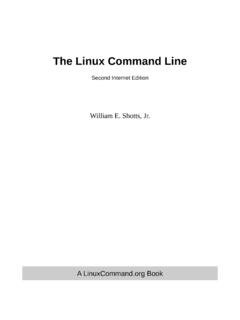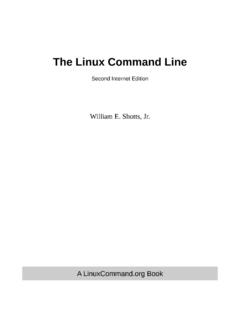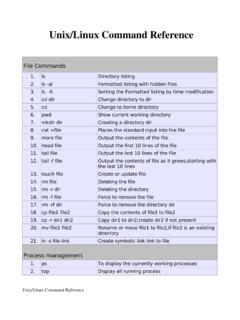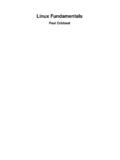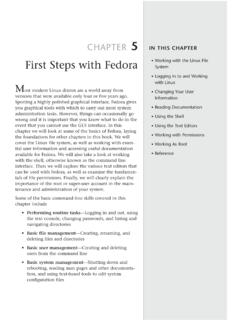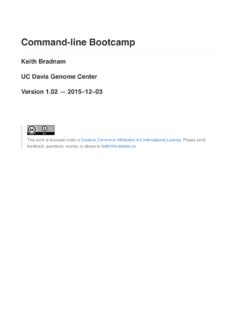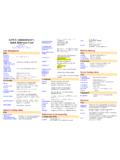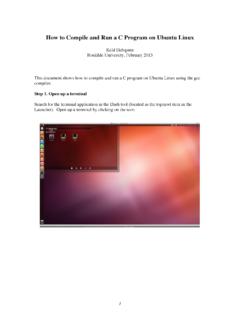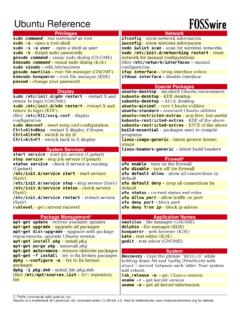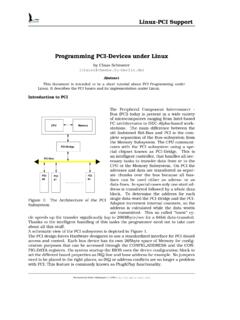Transcription of Linux terminal commands - homes.sice.indiana.edu
1 Linux terminal commandsLinux has a very powerful command - line interface, which is invoked by typing commandsinto a terminal or xterm window directly (like the DOS/CMD window in Windows). Thissmall note can help you get started learning some of these commands ; remember that muchmore detailed descriptions are available online, in particular: the labs, click onApplications->accessories->terminalto open up the terminalwindow which gives you access to the command prompt. If you log into the machines fromhome using PuTTY, then you type these commands in the PuTTY are some common commands : mkdir:make directory(a directory is often called afolderin windows). A directory isa special file on the storage device that can contain other files. For instance, mkdircs1073 will create the directory/foldercs1073in the present working directory.
2 Pwd:print working directory. Shows where you are in the file system ( are you atyour top directory, or deep in nested folders)? For instance, right after I log in, if Itype pwd , I get:main205>pwd/home/whaley cd:change directory. This is the way to move around in the filesystem. For instance,if I typecd cs1073then I will change into the subdirectory (a subdirectory is a folderwhich is contained within another folder)cs1073. There are two special directory handles that you use when issuing command are:1../ : the current directory the command prompt is in. For example ./xc2f runs the programxc2fwhich can be found in the present working ../ : the directory immediately above the current one. Can be repeated as oftenas you like. For instance ../../xc2f runs the programxc2fwhich is found inthe directory two levels above the current one.
3 When you provide where the file is to be found, this is called thepath. So for ../../xc2f , ../../ is therelative path(because the path is relative to thecurrent working directory), and xc2f is thefile name. Afully qualified pathorabsolute pathis one that is not dependent on the directory where you currentlyare. For instance /home/whaley/cs1073 is a fully qualified path. ls:list. Prints out what files are available in the present working directory. Importantflags include -A , which says to list hidden files as well as normal files, and -l whichsays to list with long format (providing more information about all files. man:manual. Print man page of provided command . For instance, man ls providesthe system help on using the cp:copy. Copy a file to another file. For instance cp will copythe that the same data exists as the the same directory.)
4 Linux filename commands have the special character . , which means Using thesame filename when given as a target for commands likecpormv. For instance cp ../. will duplicate the the directory above thisone, using the mv:move. Copy a file to a new file/path, and delete the original file. For instance, will result in replicating the , and then deletingthe original filename ( ). rm:remove. Delete the provided file(s). For instance rm will permenentlydelete the this command with care, since you can delete every fileyou own if you are not careful. I recommend that you always use the-iflag, whichwill causermto ask you if you really want to delete. You can ensure this by typing alias rm rm -i before ever usingrm. rmdir:remove directory. Delete the specified directory. This command only works ifthe directory is empty.
5 History: print a listing of most recent commands the user has entered. You can thenrepeat a command using the!. For instance!110will repeat the command with thelabel110from thehistorylisting. For most shells, hitting the up arrow will take you one command back in yourhistory, the down arrow will take you one command forward in your history,and the left and right arrows allow you to move around in these rememberedcommands so that you can edit them. cat:concatonate. Takes a list of text files, and prints them to screen, starting withthe first file in the list and ending with the last. If used with only one file, it types itscontents to the screen. diff:difference. Compares two different text files, and displays any differences line -by- line to the screen. If there is no output, then the files contain the exact same useful for making your output match someone else s exactly, or to see what haschanged between versions of a program.
6 Grep:global regular expresion print: search for given pattern/patterns in the providelist of files and print any occurances line -by- line to the screen. Has simple formgreppattern [files]. gfortran: invoke the Fortran 95 compiler. For example: gfortran -g -Wall -oxc2f will compile the program that has been saved to the the present working directory, and place the executable in thefilenamexc2fin the same directory (under windows, extension will beautomatically added to the filename, but this is not true for Linux ). mail < : mail the the TA. Youwhould the filename of your program. You should havecomments describing your name and any collaborators at the top of the file. pine: a simple non-graphical e-mail client2 Example sessionThe following is an actual screen dump of a terminal session showing how one can use someof the outlined commands (I have added some blank lines to make it slightly easier to follow).
7 I start on my office machine (drteeth), and I log into the (I do this usingsshsince my machine runs Linux ; OS X users can also usessh; Windowsusers can usePuTTY). In this session, I create a directory for all of my CS 1073 files, andthen I create subdirectories so that it is easy to find files later. Note that the sentencesprefaced with#were not typed in by me or printed out by the terminal : they are commentsthat I have adde to explain what I was doing during the where you type the commands in the terminal window. Different usershave different prompts (and you can change them if you know how). My prompt ismachinename>. So, onmain201it will be main201> . Your prompt may machinesmain201throughmain205should be available for remote login to Linux 24hours day. Other machines are available or not depending on if they have been booted intoLinux or Windows.
8 These machines includeant00 ant34,bat00 bat55,cat00 cat32,dog00 that if you type the first few letters of a file name and then hit theTabkey, theshell will usually autocomplete the file name!drteeth>ssh main201whaley@main201 s password:Last login: Tue Jul 21 15:47:13 2009 from >pwd/home/whaleymain201>mkdir cs1073 # create class dir in home areamain201>cd cs1073/ # go to class subdirmain201>ls # no files in subdir yetmain201>ls -a # -a shows hidden/virtual ../main201>cp ../lec/* . # copy all files in ../lecmain201>ls # see what files I copied xconvert* * ~ xpoke*main201>rm *.exe x* *.pdf ~ # get rid of unneeded filesmain201> >mv # get better name for programmain201> >gfortran -Wall -g -o xc2f # compile programmain201>ls # see if executable is xc2f*3main201>.
9 /xc2f # run programWhat is the temperature in Centigrade? degrees Centigrade is degrees in Fahrenheitmain201>gfortran -Wall -g -o xloser # compile program 2main201>./xloser # run prog 2 Please enter an integer between 1 and 5002 Please enter your first name:ClintThanks Clint! Now please enter your last name:WhaleyClint Whaley is a complete loser!Clint Whaley is a complete loser!main201> xc2f* xloser*main201>rm x* # get rid of executablesmain201>ls # see files that >mkdir lab1 # create directory for 1st labmain201>mv *.f90 lab1/. # put f90 files into itmain201>lslab1/main201>ls lab1/ # make sure they are >mkdir asg1 # create dir for asg 1main201>cp lab1 asg1 # use c2f as start for f2cmain201>ls >cd asg1 ; ls # cd to asg1, list command - line Information File completion: when typing, the shell can autocomplete most words for you.
10 Typethe first several characters of the word, and then hit thetabkey. If the filename isnot autocompleted, there may be other filenames that begin with the same prefix, soyou need to type a few more characters and hittabagain until the prefix you havetyped is unambiguous. In the bash shell, hittingtabtwice will give a list of possiblecompletions, whilectrl-Ddoes the same for the tcsh shell. Unix wild-carding: On the command line the*character means match anything ,while?means match any one character, while the brackets provide a way to match arange or list of certain characters. Here s some examples: ls *.dat: lists all files in current directory ending ls *hello*: lists all files with the word hello embedded in their names cat output[0-9].out: prints out all files with the formoutputfollowed by asingle digit, followed the screen.
